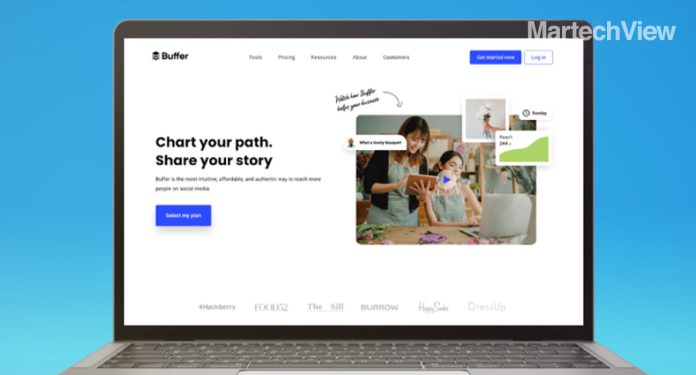Explore the highs and lows of Buffer’s journey from a $5 profit to a leading social media management platform. Learn their strategies for growth and customer focus.
A profit of $5 in his PayPal account got Joel Gascoigne so excited that the floorboards creaked as he jumped around his room. This was a promising beginning for Buffer, the social media management startup, four days after its launch in 2010.
In 2014, Buffer was offered a nine-figure offer from an undisclosed company. Serving as a green flag for the wonders the company could do, Gascoigne, the Buffer CEO, and co-founder Leo Widrich reflected on their business vision and goals. Although the acquisition could have been a life-changing decision, the duo believed there was more growth and greater achievements to be celebrated. And they were right.
“Here I am six years later, still energized and happy with my gradual return, so overall, I believe that worked out,” wrote Gascoigne in a post.
REWIND: Idea Buffering…
The year was 2010, and Twitter enthusiast Gascoigne enjoyed conversing with his followers. Aspiring to increase online engagement, he posted five dedicated tweets daily. But keeping track of the time stamp on a notepad frustrated him, so the idea of Buffer began to take shape.
He began to read about the lean startup methodology and figured that the key to a successful startup would be testing relevant audiences. He created a simple landing page and shared it with his then 1,700 Twitter followers. He tracked the metrics and listened to what his possible customers had to say.
Some said they wouldn’t use it, some did not understand it, while others were excited. Gascoigne added a third page to determine if people would pay to use it. Some found it absurd, while others were willing. With first-party data research, the founders finally created the full product.
Having no expertise in building an Android or an iPhone application, they settled for a simple web application and a Chrome extension. The product was launched in seven weeks with limited features and access to Twitter. They witnessed 100 sign-ups along with three paying customers in the first month. Reaching Ramen profitability in early 2011, Gascoigne reduced his contract development work and focused on Buffer.
Buffer Troubles
After hitting 20,000 users in 2011, they packed their bags and moved their workstations from the UK to San Francisco. Buffer turned from a scheduling application to a social media management platform. As expats in the US, the founders had trouble raising funds when they began to run out of money.
Although they were refused by 88% of potential investors they approached, with enough perseverance, Buffer totaled 18 investors in 2011 and raised $450,000 to help build the company. Around that time, the platform began to offer social media services on LinkedIn, Facebook, and Google+, apart from Twitter.
The company faced another challenge in 2013 – a security breach. While the vulnerability was patched and security was strengthened, Buffer inspected the breach and reported that the backdoor was created by its partners MongoHQ and GitHub.
Hackers could impersonate employees and gain admin access to view buffer information. The breach was a wake-up call for Buffer to strengthen security. The team added encryption of OAuth access tokens and changed all API calls to use an added security parameter.
One of their most recent challenges was when the company had to use almost half of its money in the bank to buy out the main venture capital investors in 2018. This decision was made due to a series of events — from profitability issues, slow growth rate, departure of Widrich, and Gascoigne’s firm decision to not compromise on their work culture.
Also Read: How AI and Data Analytics Are Transforming Customer Experience
Buffer Culture
Customer opinion and customer satisfaction matter a great deal to the company. In fact, 25% of the team is dedicated to customer support, including engineers who might understand users’ issues with their built features, which might help them create better products.
Buffer also includes a monthly Happiness report of insights and analytics that help them meet customer expectations. For instance, in 2013, the company recorded 4,335 e-mail conversations, answered 52% of emails within an hour, and had a 98% customer satisfaction turnout. Winning over 1,000,000 users, the team committed itself to enhancing CX with tools such as Help Scout and Sparkcentral.

Since 2015, Buffer has been known for its transparency. They disclosed employee salaries and equity, exposed company financials, revealed how customers’ payments are used, and surfaced internal metrics. We checked out its transparent revenue dashboard, and it revealed that the company’s current annual run rate is over $20 million. It’s a refreshing company culture; their marketing strategies are no different.
The Buffed Marketing Plan
The Buffer blog was created in January 2011 with a content marketing strategy. From three articles a month to four a week, marketing their new features through content marketing helped them gain visibility. Soon, Buffer had over 45 guest writers to keep up with the demand. Collaborating with the AngelPad platform, posts became a daily affair, and some hit 8000 shares. The team journeyed from zero to over 1.5 million monthly visits.
Meanwhile, the marketing team expanded from the US and Canada to the UK and Singapore, focused on keeping up with the marketing trends and technology for better visual planning and scheduling of social media campaigns.
Building its tool stack, the company added over 60 martech tools by 2017 to drive engagement, coordinate creativity, and enhance social media relationships. The Buffer marketers use Trello for organization, Looker for data, Sketch for design, Dropbox Paper for collaboration, Ulysses writing tool, Pocket curation tool, Placeit graphics tool, and Okta for security.
Bufferful Kit
Nike handles over 1,000,000 conversations per year across 200 different social media accounts. Blank Tag Co., a smaller business that began from $0, generated more than $100,000 yearly from just Instagram ads. For research, the Buffer content team talks to several companies whose social media game leads them to the top of the ladder.
Besides being Facebook’s marketing partner under Community Management, Pinterest, and LinkedIn’s marketing partner, Buffer has ties with various software applications and companies, including WordPress, Twitter, Zapier, Feedly, Reeder, Quuu, and Pocket. Over the years, they also launched several tools and features for a better customer experience.
In 2018, Buffer introduced Stories Creator, a free tool to help users create graphics in minutes. The tool features an Instagram Stories UI overlay for previews. In 2019, Buffer launched a Hashtag Manager tool to help customers organize hashtags by creating and saving groups directly within the Buffer composer.
Apart from their publishing and engagement tools, Buffer introduced LinkedIn Analytics in 2020. In collaboration with LinkedIn, the feature allows customers to understand what’s working for brands and get better results on the professional social media network.
In August 2021, Buffer collaborated with Canva to allow customers to download images from Canva and design, create, and publish posts without leaving the Buffer platform.
More recently, in October 2021, Buffer launched the Start Page. Combined with its social media tools, the Start Page tool allows customers to generate a landing page and URL, complete with a product showcase, content, events, and announcements, all from one link.
Also Read: Understanding Composable Tech Stack
The Buffered Acquisitions
In 2012, Buffer made its first acquisition, Sharefeed, and hired CEO Hiten Shah as a mentor. Buffer utilized Sharefeed’s user flow and engagement data, including retention and activation metrics. A Buffer extension was rolled out, allowing users to “buffer” directly from Facebook or Twitter platforms.
Buffer acquired Respondly, a social media customer service and brand monitoring tool, in 2015 to build a social media customer service product. Rebranding it as Buffer Reply, it became a standalone tool for social media customer support, engagement, community, and monitoring.
Although Reply brought the initial success of monthly revenue $4k to over $70k at its peak, Buffer realized that the need for customer service on social media was less widespread and had not developed as they had imagined. So, they dropped Reply in 2020 and have focused on social engagement since then.
What’s Buffering?
Although the pandemic brought around the worst churn rate for Buffer as businesses struggled to survive, the decline eased, and growth rates have stabilized. The social media platform is eyeing sustainability and profitability.
We looked at Buffer’s transparent product roadmap on Trello, and it’s both unusual and exciting to be able to see their behind-the-scenes plans in tabs such as “In Progress”, “Done!”, and “Exploring”.
The Buffer team is working on an improved version of the Calendar to help customers plan their posts better. Also, work is still underway to create a free landing page. The company has other prospects in its to-do list, including LinkedIn Tagging, Native LinkedIn videos, Instagram grid previews, better previews of posts, and more integrations for importing content.
While they contend with popular platforms such as Sprinklr, Sprout Social, Clickable Inc, SocialFlow, and BuzzSumo, Buffer’s USP is transparent culture, affordability, and vision for long-term sustainability with enhanced CX. Serving seven million users and helping 75,000 brands worldwide, including Microsoft, Huckberry, GitHub, Shopify, and Trello, the Buffer journey might just get bigger and better.










